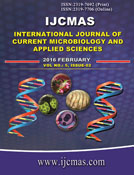


 National Academy of Agricultural Sciences (NAAS)
National Academy of Agricultural Sciences (NAAS)

|
PRINT ISSN : 2319-7692
Online ISSN : 2319-7706 Issues : 12 per year Publisher : Excellent Publishers Email : editorijcmas@gmail.com / submit@ijcmas.com Editor-in-chief: Dr.M.Prakash Index Copernicus ICV 2018: 95.39 NAAS RATING 2020: 5.38 |
Man-made recreational fountains are on the rise thanks to greater urbanization and mushrooming of tourist places of attraction. There is also greater availability of communal shower facilities especially at public beaches. Public perception is that both fountain and public shower water are microbiologically safe and there is little awareness of the potential for recreational water to spread infectious diseases. This study purports to assess the microbial safety, sanitary and physico-chemical quality of water from public fountains and showers. The specific objectives were to test for the (i) level of fecal indicator bacteria (Enterococcus fecalis and Escherichia coli), (ii) presence of autochthonous waterborne pathogens (Clostridium perfringens, Pseudomonas and Legionella), and (iii) physico-chemical properties of water, with the view to assessing their overall compliance with legal limits. Samples were aseptically collected from five highly frequented fountains of Mauritius,and five public showers from Northern beaches of the island. Physicochemical test parameters included pH, Electrical conductivity (EC) and Total Suspended Solids (TSS). Samples were also plated on Plate Count Agar, Eosin Methylene Blue Agar, Enterococcus Agar, Pseudomonas agar, Iron Sulphite Agar and Buffered Charcoal Yeast Extract Agar for enumeration of Total Viable Counts, E. coli, E. fecalis, Pseudomonas spp, C. perfringens, and Legionella respectively. Values of pH, EC and TSS of fountain and shower water samples were below legal upper limits and fell in the range of 7.3-7.9, 100-375 μS/cm, 800-975 mg/L and 7.3-7.6, 200-680 μS/cm and 580-1100 mg/L respectively. Pseudomonas spp. was detected in all fountain water samples (1.5 – 3.0 log cfu/ml) and shower water (0.06 – 3.2 log cfu/ml) but within the tolerance range. The absence of E. coli, E. fecalis, C. perfringens and Legionella in all water samples was confirmed by culturing and molecular assays. Findings of this study indicate that most waterborne pathogens as well as fecal contaminants were undetectable in these water systems thus corroborating their safety for public use
 |
 |
 |
 |
 |